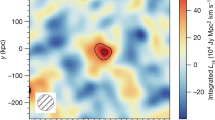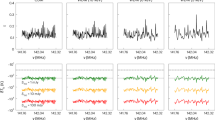Abstract
The existence of the cosmic microwave background radiation is a fundamental prediction of hot Big Bang cosmology, and its temperature should increase with increasing redshift. At the present time (redshift z = 0), the temperature has been determined with high precision to be TCMBR(0) = 2.726 ± 0.010 K. In principle, the background temperature can be determined using measurements of the relative populations of atomic fine-structure levels, which are excited by the background radiation. But all previous measurements have achieved only upper limits, thus still formally permitting the radiation temperature to be constant with increasing redshift. Here we report the detection of absorption lines from the first and second fine-structure levels of neutral carbon atoms in an isolated cloud of gas at z = 2.3371. We also detected absorption due to several rotational transitions of molecular hydrogen, and fine-structure lines of singly ionized carbon. These constraints enable us to determine that the background radiation was indeed warmer in the past: we find that TCMBR(z = 2.3371) is between 6.0 and 14 K. This is in accord with the temperature of 9.1 K predicted by hot Big Bang cosmology.
This is a preview of subscription content, access via your institution
Access options
Subscribe to this journal
Receive 51 print issues and online access
$199.00 per year
only $3.90 per issue
Buy this article
- Purchase on Springer Link
- Instant access to full article PDF
Prices may be subject to local taxes which are calculated during checkout





Similar content being viewed by others
References
Alpher, R. A., Bethe, H. A. & Gamov, G. Evolution of chemical elements. Phys. Rev. 73, 803–804 (1948).
Penzias, A. A. & Wilson, R. A measurement of excess antenna temperature at 4080 Mc/s. Astrophys. J. 142, 419–421 (1965).
Mather, J. C. et al. Measurement of the cosmic microwave background spectrum by the COBE FIRAS instrument. Astrophys. J. 420, 439–444 (1994).
Bahcall, J. N., Joss, P. C. & Lynds, R. On the temperature of the microwave background radiation at a large redshift. Astrophys. J. 182, L95–L98 (1973).
Meyer, D. M., Black, J. H., Chaffee, F. H., Foltz, C. B. & York, D. G. An upper limit on the microwave background temperature at z = 1.776. Astrophys. J. 308, L37–L41 (1986).
Songaila, A. et al. Measurement of the microwave background temperature at a redshift of 1.776. Nature 371, 43–45 (1994).
Songaila, A., Cowie, L. L., Hogan, C. & Rugers, M. Deuterium abundance and background radiation temperature in high redshift primordial clouds. Nature 368, 599–604 (1994).
Lu, L., Wargent, W. L. W., Womble, D. S. & Barlow, T. A. Abundances at high redshifts: The chemical enrichment history of damped Lyman-α galaxies. Astrophys. J. Suppl. Ser. 107, 475–520 (1996).
Ge, J., Bechtold, J. & Black, J. H. A new measurement of the cosmic microwave background radiation temperature at z = 1.97. Astrophys. J. 474, 67–73 (1997).
Roth, K. C. & Bauer, J. M. The z = 1.6748 C I absorber toward PKS 1756+237. Astrophys. J. 515, L57–L60 (1999).
D'odorico, S. et al. Performance of UVES, the echelle spectrograph for the ESO VLT and highlights of the first observations of stars and quasors. Proc. SPIE 4005, 121–130 (2000).
Welty, D. E. et al. The diffuse interstellar cloud toward 23 Orionis. Astrophys. J. Suppl. Ser. 124, 465–501 (1999).
Savage, B. D. & Sembach, K. R. Interstellar abundances from absorption-line observations with the Hubble space telescope. Annu. Rev. Astron. Astrophys. 34, 279–330 (1996).
Pettini, M., Smith, L. J., King, D. L. & Hunstead, R. W. The metallicity of high-redshift galaxies: the abundance of zinc in 34 damped Lyman-α systems from z = 0.7 to 3.4. Astrophys. J. 486, 665–680 (1997).
Ge, J. & Bechtold, J. in Highly Redshifted Radio Lines (eds Carilli, C. L., Radford, S. J. E., Menten, K. M. & Langston, G. I.) 121–131 (ASP Conf. Series Vol. 156, 1999).
Shull, J. M. et al. FUSE observations of diffuse interstellar molecular hydrogen. Astrophys. J. 538, L73–L76 (2000).
Jura, M. Interstellar clouds containing optically thick H2. Astrophys. J. 197, 581–586 (1975).
Dalgarno, A. & Wright, E. L. Infrared emissivities of H2 and HD. Astrophys. J. 174, L49–L51 (1972).
Srianand, R. & Petitjean, P. Molecules in the zabs = 2.8112 damped system toward PKS 0528-250. Astron. Astrophys. 335, 33–40 (1998).
Bahcall, J. N. & Wolf, R. A. Fine-structure transitions. Astrophys. J. 152, 701–729 (1968).
Timmes, F. X., Lauroesch, J. J. & Truran, J. W. Abundance histories of QSO absorption systems. Astrophys. J. 518, 468–476 (1995).
Nussbaumer, H. & Rusca, C. Forbidden transitions in the C I sequence. Astron. Astrophys. 72, 129–133 (1979).
Launay, J. M. & Roueff, E. Fine structure excitation of carbon and oxygen by atomic hydrogen impact. Astron. Astrophys. 56, 289–292 (1977).
Jenkins, E. B. & Shaya, E. J. A survey of interstellar C I insight on carbon abundances UV grain albedoes, and pressures in the interstellar medium. Astrophys. J. 231, 55–72 (1979).
Keenan, F. P., Lennon, D. J., Johnson, C. T. & Kingston, A. E. Fine structure population for the 2P ground states of C II. Mon. Not. R. Astron. Soc. 220, 571–576 (1986).
Roth, K. C. & Meyer, D. M. Cyanogen excitation in diffuse interstellar cloud. Astrophys. J. 441, 129–143 (1995).
Sunyaev, R. A. & Zeldovich, Ya. B. The velocity of clusters of galaxies relative to the microwave background—The possibility of its measurement. Mon. Not. R. Astron. Soc. 190, 413–420 (1980).
Morton, D. C. Atomic data for resonance absorption lines. I—Wavelengths longward of the Lyman limit. Astrophys. J. Suppl. Ser. 77, 119–202 (1991).
Acknowledgements
The observations presented here have been obtained using the Ultra-violet and Visible Echelle Spectrograph mounted on the 8.2-m KUEYEN telescope operated by the European Southern Observatory at Paranal, Chile. P.P. thanks A. Kaufer and M. Chadid for their kind and efficient assistance at the telescope and IUCAA for hospitality during the time this work was being done. We thank T. Padmanabhan for useful comments. We gratefully acknowledge support from the Indo-French Centre for the Promotion of Advanced Research (Centre Franco-Indien pour la Promotion de la Recherche Avancée).
Author information
Authors and Affiliations
Rights and permissions
About this article
Cite this article
Srianand, R., Petitjean, P. & Ledoux, C. The cosmic microwave background radiation temperature at a redshift of 2.34. Nature 408, 931–935 (2000). https://doi.org/10.1038/35050020
Received:
Accepted:
Issue Date:
DOI: https://doi.org/10.1038/35050020
This article is cited by
-
Microwave background temperature at a redshift of 6.34 from H2O absorption
Nature (2022)
-
In-Orbit Calibration Uncertainty of the Microwave Radiation Imager on board Fengyun-3C
Journal of Meteorological Research (2021)
-
Testing creation cold dark matter cosmology with the radiation temperature–redshift relation
General Relativity and Gravitation (2019)
-
The Diffuse Light of the Universe
Foundations of Physics (2017)
-
Limits on decaying dark energy density models from the CMB temperature–redshift relation
General Relativity and Gravitation (2011)
Comments
By submitting a comment you agree to abide by our Terms and Community Guidelines. If you find something abusive or that does not comply with our terms or guidelines please flag it as inappropriate.



